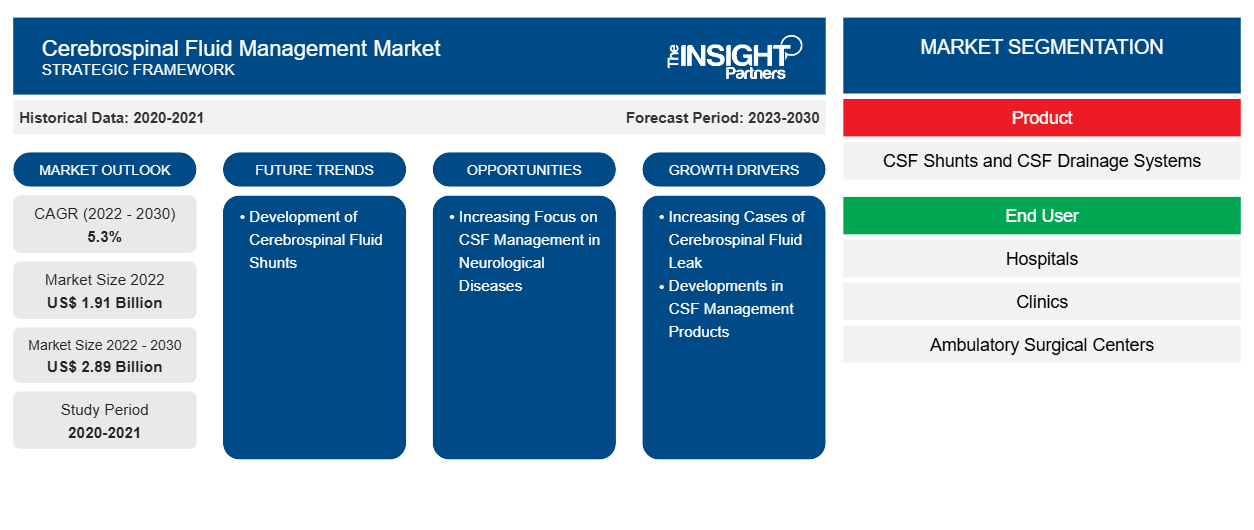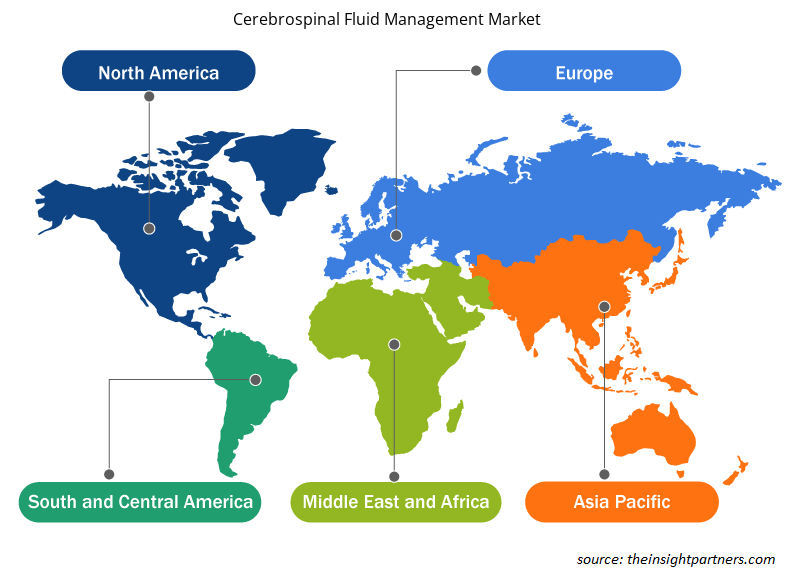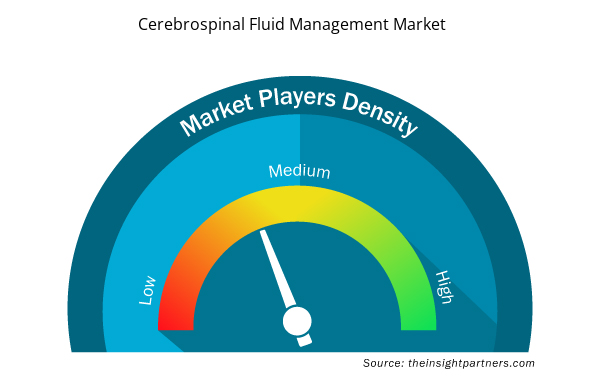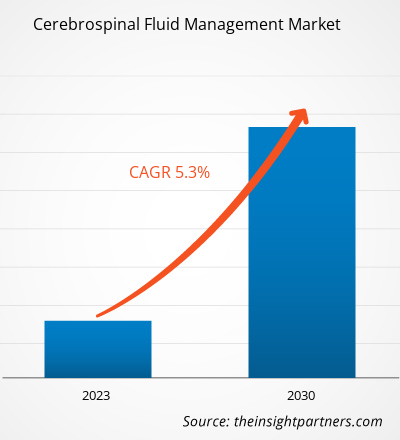[Research Report] The cerebrospinal fluid management market was valued at US$ 1,911.37 million in 2022 and is expected to reach US$ 2,892.54 million by 2030. It is estimated to register a CAGR of 5.3% during 2022–2030.
Market Insights and Analyst View:
The cerebrospinal fluid management market size is growing rapidly due to the adoption of minimally invasive procedures to manage and treat cerebrospinal fluid (CSF) leaks. Also, the growth of the market is defined due to the growing developments in the medical device industry that are enabling the commercialization of innovative CSF shunts and CSF drainage systems. Apart from the growing developments, governments in different regions support using CSF management devices to address the rising concerns of hydrocephalus and other neurological conditions.
In addition, governments have enhanced funding to expand the research and development for neurological disorders. For instance, in May 2022, the National Institute of Neurological Disorders and Stroke, part of the National Institutes of Health, offered five-year funding to a team of researchers at McGovern Medical School researchers with US$ 2.85 million. The funds are expected to be used to study novel technology in babies with hydrocephalus. The technology will deploy techniques to understand the role of cerebrospinal fluid flow dynamics in post-hemorrhagic hydrocephalus (PHH). The study will enable to develop prevention, progression, and treatment strategies. The commercialization of the new technology will boost the market value in the coming years.
Customize This Report To Suit Your Requirement
You will get customization on any report - free of charge - including parts of this report, or country-level analysis, Excel Data pack, as well as avail great offers and discounts for start-ups & universities
Cerebrospinal Fluid Management Market: Strategic Insights

- Get Top Key Market Trends of this report.This FREE sample will include data analysis, ranging from market trends to estimates and forecasts.
Customize This Report To Suit Your Requirement
You will get customization on any report - free of charge - including parts of this report, or country-level analysis, Excel Data pack, as well as avail great offers and discounts for start-ups & universities
Cerebrospinal Fluid Management Market: Strategic Insights

- Get Top Key Market Trends of this report.This FREE sample will include data analysis, ranging from market trends to estimates and forecasts.
Growth Drivers and Challenges:
According to the Journal of Neurosurgery, more than 69 million people globally are estimated to suffer from traumatic brain injuries annually. The incidences are expected to be the highest in regions such as Southeast Asia and Western Pacific. Brain and spinal injuries are the most common causes of cerebrospinal fluid (CSF) leaks in adults, necessitating CSF management. High blood pressure, majorly caused due to a shift in lifestyle and unhealthy habits, is another notable cause of CSF leaks among adults and elderlies. Similarly, high blood pressure is common in elderly people, which ultimately leads to an increasing risk of idiopathic intracranial hypertension (IIH). Thus, the growing geriatric population can be associated with the growth of the cerebrospinal fluid management market.
The incidence of hydrocephalus is growing significantly across the world. The occurrence of hydrocephalus is highest in the geriatric population; notably, it is higher in the pediatric population than adults. According to an article published by the National Library of Medicine (NLM), the global prevalence of hydrocephalus is ~85 per 100,000 individuals. As per the same source, the prevalence rate in the pediatric population is ~88 per 100,000, whereas the rate is ~11 per 100,000 in adults and ~175 per 100,000 in the geriatric population. Further, the incidence rate of hydrocephalus in low- and medium-income countries is ~123 per 100,000 births, while the rate in high-income countries is 79 per 100,000 births. The CSF shunts and drainage systems are the treatment options suitable for hydrocephalus cases diagnosed in people of all age groups. Hence, an increase in CSF leak cases boosts the growth of the CSF management market.
In contrast, the risk of failure and manufacturing is an important factor restraining the market's growth. Patients face many complications after the placement of CSF shunts, mainly due to the possible risk of malfunction, infection, and improper functioning. The major reasons for shunt malfunctioning include proximal and distal catheter occlusion, disconnection, and infection. The adverse effects are equally common in both youngsters and the elderly population. CSF shunting procedures need constant monitoring and require follow-up visits to clinics and hospitals due to the possibility of malfunctioning of valves, which may result in changes in CSF flow pressure, leading to over drainage or underdrainage.
Report Segmentation and Scope:
The cerebrospinal fluid management market share is divided on the basis of product and end user. Based on product, the market is classified into CSF shunts and CSF drainage systems. In 2022, the CSF shunts segment held a larger market share and is estimated to grow at a significant CAGR during the forecast period (2022-2030). The CSF shunts segment is further categorized into ventriculoperitoneal shunts, ventriculoatrial shunts, ventriculopleural shunts, and lumboperitoneal shunts. Similarly, the CSF drainage system is classified into external ventricular drainage (EVD) systems and lumbar drainage (LD) systems. The overall growth of the market, by product, is attributed to growing product launches, increasing demand for advanced CSF shunts, and increasing incidences of hydrocephalus.
Based on end user, the market is classified into hospitals, clinics, ambulatory surgical centers, and neurological centers. In 2022, the hospitals segment held the largest market share, by end user, and is expected to grow at the fastest rate during the coming years. Based on geography, the market is divided into North America (the US, Canada, and Mexico), Europe (the UK, Germany, France, Italy, Spain, and the Rest of Europe), Asia Pacific (China, Japan, India, South Korea, Australia, and the Rest of Asia Pacific), Middle East & Africa (the UAE, Saudi Arabia, South Africa, and the Rest of Middle East & Africa), and South & Central America (Brazil, Argentina, and the Rest of South & Central America).
Segmental Analysis:
Based on product, the Cerebrospinal Fluid Management Market is segmented into CSF shunts and CSF drainage systems. The CSF shunts segment held a larger market share and is expected to register a significant CAGR during the forecast period (2022-2030). CSF shunts are widely used for the treatment of hydrocephalus. These shunts consist of silastic tubes that allow the diversion of CSF from ventricles to body cavities such as peritoneum, right cardiac atrium, or pleural space. Different types of shunts available in the cerebrospinal fluid management market are classified as ventriculoperitoneal shunts, ventriculoatrial shunts, ventriculopleural shunts, and lumboperitoneal shunts. These shunts are developed to open at specified pressure levels and remain open until the pressure differential across the valve crosses the pressures at the time of opening.
The cerebrospinal fluid management market is widely driven by the presence of well-established and budding players across the world. In May 2020, Aesculap Inc., along with The Christoph Miethke GmbH & Co. KG (MIETHKE), launched the M.blue valve for the treatment of hydrocephalus. M.blue, enabled with gravitational technology, is integrated with a fixed differential pressure unit in one valve, which unlocks a simple, position-dependent solution. Thus, product developments are likely to foster market growth during the forecast period.
Based on end user, theCerebrospinalFluid Management Market is segmented into hospitals, clinics, ambulatory surgical centers, and neurological centers. In 2022, the hospitals segment held the largest market share, by end user. It is expected to grow at the fastest rate during the coming years.
Regional Analysis:
Based on geography, the cerebrospinal fluid management market is divided into North America, Europe, Asia Pacific, Middle East & Africa, and South & Central America. North America is the largest contributor to the growth of the market, and Asia Pacific is the fastest-growing region. The growth of the market in North America is attributed to factors including increasing hydrocephalus, traumatic brain injury, and other neurological condition incidences, rapid technological innovations, and developing healthcare infrastructure. Based on countries analyzed in North America, the US is the largest market share holder. According to the latest March 2023 update by the National Institutes of Health (NIH), 2 in every 1,000 babies are diagnosed with hydrocephalus in the US. The incidence of hydrocephalus in children in the country is as common as that of Down syndrome. The incidence rate of pediatric hydrocephalus is ~0.1–0.6% of live births. The incidence of hydrocephalus in children is a prime factor resulting in an elevated demand for cerebrospinal fluid management devices in the US. A research article “Management of Hydrocephalus in Children: Anatomic Imaging Appearances of CSF Shunts and Their Complications,” published in the American Journal of Roentgenology in October 2020, states hydrocephalus affects 1–2% of the US population. It results in nearly 70,000 hospital admissions, resulting in the insertion of 18,000–33,000 CSF shunts annually. Such high stats indicate that the country is witnessing a rising number of brain surgeries, which require the placement of cerebrospinal fluid (CSF) management devices. In addition, it is not known how many people develop hydrocephalus after birth. It is diagnosed as one progresses in age. Thus, the demand for CSF shunts is likely to grow in the US.
Similarly, the growth of the market in Asia Pacific is determined by factors such as the growing geriatric population, demand for advanced medical devices, and increasing healthcare infrastructures offering efficient treatments. In Asia Pacific, China is the largest contributor to the market growth. The cerebrospinal fluid management market in China is driven by the increasing prevalence of normal-pressure hydrocephalus and traumatic brain injury (TBI) among the elderly in the country.
Industry Developments and Future Opportunities:
Various initiatives by key players operating in the Cerebrospinal Fluid Management Market are listed below:
- In December 2021, Spiegelberg Contract signed with Innovative Medcare PTY Ltd. Innovative Medcare Technology PTY LTD located in Melbourne, Australia, had joined the strong growing Spiegelberg family.
- In April 2021, Medtronic plc and Surgical Theater announced a partnership to interface Surgical Theater's SyncAR augmented reality (AR) technology with Medtronic's StealthStation S8 surgical navigation system. This collaboration will enable neurosurgeons to use AR technology in real-time to enhance visualization during complex cranial procedures.
- In March 2023, Möller Medical GmbH recalled Drainage Set LiquoGuard 7, as leakage was detected in isolated cases, which were part of ongoing quality and market monitoring processes.
Cerebrospinal Fluid Management Market Regional Insights
Cerebrospinal Fluid Management Market Regional Insights
The regional trends and factors influencing the Cerebrospinal Fluid Management Market throughout the forecast period have been thoroughly explained by the analysts at Insight Partners. This section also discusses Cerebrospinal Fluid Management Market segments and geography across North America, Europe, Asia Pacific, Middle East and Africa, and South and Central America.

- Get the Regional Specific Data for Cerebrospinal Fluid Management Market
Cerebrospinal Fluid Management Market Report Scope
| Report Attribute | Details |
|---|---|
| Market size in 2022 | US$ 1.91 Billion |
| Market Size by 2030 | US$ 2.89 Billion |
| Global CAGR (2022 - 2030) | 5.3% |
| Historical Data | 2020-2021 |
| Forecast period | 2023-2030 |
| Segments Covered |
By Product
|
| Regions and Countries Covered | North America
|
| Market leaders and key company profiles |
Cerebrospinal Fluid Management Market Players Density: Understanding Its Impact on Business Dynamics
The Cerebrospinal Fluid Management Market market is growing rapidly, driven by increasing end-user demand due to factors such as evolving consumer preferences, technological advancements, and greater awareness of the product's benefits. As demand rises, businesses are expanding their offerings, innovating to meet consumer needs, and capitalizing on emerging trends, which further fuels market growth.
Market players density refers to the distribution of firms or companies operating within a particular market or industry. It indicates how many competitors (market players) are present in a given market space relative to its size or total market value.
Major Companies operating in the Cerebrospinal Fluid Management Market are:
- Medtronic Plc
- Integra LifeSciences Holdings Corp
- B. Braun SE
- Argi Group Health Services Ltd Sti
- Sophysa SA
Disclaimer: The companies listed above are not ranked in any particular order.

- Get the Cerebrospinal Fluid Management Market top key players overview
COVID-19 Impact:
During the pre-COVID-19 pandemic era, the treatment procedures for CSF leaks had a substantial number. For instance, in the US, CSF diversion procedures held 29% of the 843 surgeries in the neurology department from March 2019 to February 2020. The number of CSF diversion procedures significantly contributed to the market growth. Also, the demand and supply for CSF shunts and drainage systems were met efficiently. During the pandemic, the supply chain was disrupted, restricting healthcare facilities for several health conditions, including neurological diseases. The pandemic span adversely affected the market and shifted the focus of medical device companies toward the in-vitro diagnostics of COVID-19. The market was expanded for the point of care diagnostics, resulting in negative outcomes for the cerebrospinal fluid management market.
On the other hand, during the post-COVID-19 pandemic scenario, there was an exponential rise in the CSF shunt and CSF drainage procedures as acute COVID-19 infection was reported to show a direct or indirect connection to the nervous system in the many numbers of COVID-19-positive cases. However, there is limited information about the CSF outcomes with COVID-19 available that leveraged the opportunities for research and development. Post-pandemic, the awareness of the CSF shunt procedures was increased, which leveraged the market growth significantly and is expected to show a similar trend in the coming years. Product development has been increased by incorporating digital technologies to monitor and control cerebrospinal fluid flow in patients. Thus, technological advancements are contributing significantly to the growth of the market.
Competitive Landscape and Key Companies:
A few prominent players operating in the cerebrospinal fluid management market are Medtronic Plc, Integra LifeSciences Holdings Corp, B. Braun SE, Argi Group Health Services Ltd Sti, Sophysa SA, BeckerSmith Medical Inc, Delta Surgical Ltd, Moller Medical GmbH, Natus Medical Inc, and Spiegelberg GmbH & Co KG. These companies focus on new product launches and geographic expansions to meet the growing consumer demand worldwide and increase their product range in specialty portfolios. Their global presence allows them to serve a large set of customers, subsequently allowing them to expand their market share.
- Historical Analysis (2 Years), Base Year, Forecast (7 Years) with CAGR
- PEST and SWOT Analysis
- Market Size Value / Volume - Global, Regional, Country
- Industry and Competitive Landscape
- Excel Dataset


- Foot Orthotic Insoles Market
- Hydrogen Storage Alloys Market
- Data Annotation Tools Market
- Railway Braking System Market
- Semiconductor Metrology and Inspection Market
- Mesotherapy Market
- Nitrogenous Fertilizer Market
- Cling Films Market
- Europe Industrial Chillers Market
- Visualization and 3D Rendering Software Market

Report Coverage
Revenue forecast, Company Analysis, Industry landscape, Growth factors, and Trends

Segment Covered
Product, End User, and Geography

Regional Scope
North America, Europe, Asia Pacific, Middle East & Africa, South & Central America

Country Scope
This text is related
to country scope.
Frequently Asked Questions
Companies operating in the market are Medtronic Plc, Integra LifeSciences Holdings Corp, B. Braun SE, Argi Group Health Services Ltd Sti, Sophysa SA, BeckerSmith Medical Inc, Delta Surgical Ltd, Moller Medical GmbH, Natus Medical Inc, and Spiegelberg GmbH & Co KG.
Based on end user, the cerebrospinal fluid management market is segmented into hospitals, clinics, ambulatory surgical centers and neurological centers. In 2022, the hospitals segment held the largest share of the market, by end user. Moreover, same segment is expected to grow at the fastest rate during the coming years.
A cerebrospinal fluid leak is when the fluid surrounding your brain and spinal cord leaks out from where it’s supposed to be. If the leak is large enough, it can cause severe symptoms that make it hard or even impossible to go about your life as usual. Placement of cerebral spinal fluid (CSF) shunt systems to treat hydrocephalus is a common medical procedure and a life-saving treatment for many patients. These shunt systems drain excess fluid from the brain to another part of the body where the fluid is absorbed as part of the circulatory process. CSF shunts contain three main components: an in-flow tube (catheter), a valve that regulates the flow of fluid, and an outflow catheter that carries the fluid to the abdomen or the heart where the fluid can be absorbed.
Global cerebrospinal fluid management market is segmented by region into North America, Europe, Asia Pacific, the Middle East & Africa, and South & Central America. North America is likely to continue its dominance in the cerebrospinal fluid management market during 2022–2028. The US holds the largest share of the market in North America and is expected to continue this trend during the forecast period.
The factors driving the market include increasing incidences of CSF leak and growing developments for CSF management products.
Based on product, the cerebrospinal fluid management market is segmented into CSF shunts and CSF drainage systems. In 2022, the CSF shunts segment held the largest share of the market by product. and the same segment is estimated to grow at a significant CAGR during the forecast period due to growing product launches, increasing demand for advanced CSF shunts, and increasing incidences of hydrocephalus.
Trends and growth analysis reports related to Life Sciences : READ MORE..
The List of Companies - Cerebrospinal Fluid Management Market
- Medtronic Plc
- Integra LifeSciences Holdings Corp
- B. Braun SE
- Argi Group Health Services Ltd Sti
- Sophysa SA
- BeckerSmith Medical Inc
- Delta Surgical Ltd
- Moller Medical GmbH
- Natus Medical Inc
- Spiegelberg GmbH & Co KG

 Get Free Sample For
Get Free Sample For